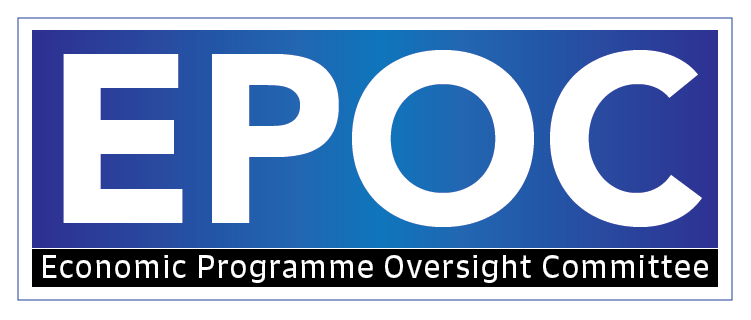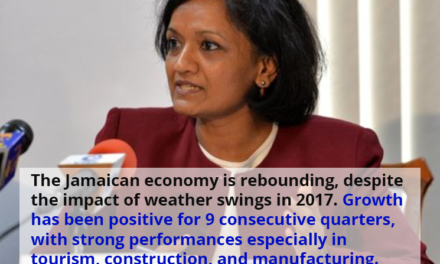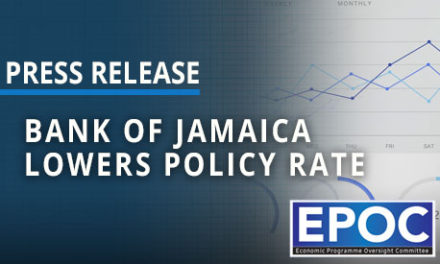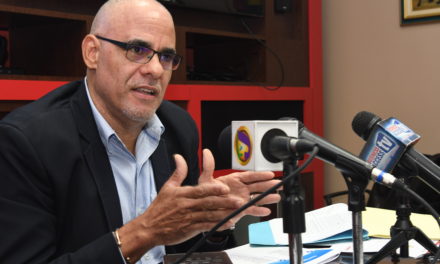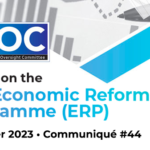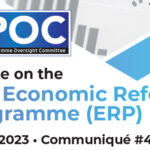Debt to GDP to 98.7%, Productive Sector loans grow 20%
Kingston, Jamaica – 26 April 2019: The International Monetary Fund (IMF) concluded the fifth and penultimate review of Jamaica’s performance under the Precautionary Standby Arrangement.
According to a release by the IMF, “Strong implementation of the reform program continues. After commendable performance under two successive Fund arrangements since May 2013, Jamaica’s public debt is projected to fall below 100 percent of GDP for the first time since FY2000/01—to 98.7 percent of GDP in FY2018/19. Unemployment is near all-time lows, business confidence is high, and the economy is estimated to have expanded by 1.8 percent in 2018, buoyed by mining, construction and agriculture. International reserves are estimated to be comfortable under a more flexible exchange rate. All quantitative performance criteria at end-December 2018 were met, and the structural benchmark to table in Parliament amendments to the Bank of Jamaica (BOJ) Act was completed in October 2018. In December 2018, however, inflation was 2.4 percent, triggering staff consultation under the Monetary Policy Consultation Clause; it remained at the same level in February 2019.”
PROGRAMME REVIEW – FISCAL PERFORMANCE
For the review period April 2018 to February 2019, the Fiscal Performance continued its positive trend.
SELECTED FISCAL INDICATORS
Tax Revenues outperform Second Supplemental Budget by $10b
Revenue & Grants of $545.0b for the first eleven months of the fiscal year (April-February) exceeded the budgeted amount of $536.9b (+1.5%) whilst Tax Revenues of $475.1b exceeded the budgeted target of $465.1b.
Tax Revenues year over year increased by $46.0b (10.7%) from $429.1b for the period April 2017 through February 2018 to $475.1b for the comparable period in FY2018/19.
EXPENDITURES BELOW BUDGET BY $12.0b
Expenditure for the first eleven months of the fiscal year (April-February) was $12.0b below budget (-2.2%).
CAPITAL EXPENDITURE UP 41.8% YEAR OVER YEAR
Capital Expenditure year over year increased by $16.3b from $39.1b for April 2017 through February 2018, to $55.5b for the comparable period in FY2018/19.
INTEREST EXPENDITURE DOWN $6.3b YEAR OVER YEAR
Interest costs up to February 2019 totalled $119b which was $6.3b below the $125.38b for the comparative period for 2017/18, and $4.5b below the budgeted figure of $123.6b for the first eleven months of the fiscal year 2018/19 (April-February), driven by lower interest rates on the GOJ debt.
PRIMARY BALANCE EXCEEDS BUDGET TARGETS BY $15.6b
As a result of the Revenue and Grants performance and the under-expenditure for the first eleven months of the fiscal year, the Primary Balance of $125.0b exceeded the $109.3b budget target for April 2018-February 2019.
MONETARY TARGETS
International Reserves
As at April 12, 2019, Jamaica’s Net International Reserves stood at US$3.110b.
Non-Borrowed Reserves
The stock of non-borrowed reserves (NBR) were US$2.632m at the end of March 2019 which was US$431.8m above the indicative targeted floor of US$2.200m.
Inflation rate increases to 3.4%
The 12-month point-to-point inflation rate at March 2019 was 3.4 per cent, below Bank of Jamaica’s target of 4.0 to 6.0 per cent, and above the 2.5% outer band for March 2019 as set out in the Monetary Policy Consultation Clause in the precautionary SBA. This increase in inflation of 0.8% in the month of March was driven primarily by a 0.9% increase in the “Food and Non-Alcoholic Beverages” division and the overall movement of 1.5% in the division “Housing, Water, Electricity, Gas and Other Fuels” due to higher electricity rates.
Foreign Exchange Market
On 18 April 2019, the value of the Jamaican Dollar vis-à-vis the US dollar was J$134.16 = US$1.00, reflecting a depreciation of 6.08 per cent ($7.69) for the Month to Date. This follows appreciation of 1.82 per cent ($2.34) for March 2019.
Real Effective Exchange Rate
As at February 2019, Jamaica recorded an annual point to point gain of 2.5% in relative price competitiveness. This gain was primarily driven by relative exchange rates as Jamaica’s nominal exchange rate depreciated at a faster pace relative to the depreciation of the trade weighted exchange rate of Jamaica’s trading partners.
Bank of Jamaica reduces Policy Rate to record low of 1.25%
On March 27, 2019, Bank of Jamaica announced its decision to lower its policy interest rate (the rate offered on current account balances of deposit taking institutions) by 25 basis points to 1.25%.
Bank of Jamaica’s decision to lower the policy rate was aimed at supporting inflation returning to and remaining on target (4.0 per cent to 6.0 per cent) by December 2020. The rate reduction was intended to stimulate an even faster expansion in private sector credit which should lead to higher economic activity, consistent with the inflation target.
ECONOMIC OVERVIEW – Recent economic data positive
Economic Growth
STATIN reported that the Jamaican economy grew by 2.0 per cent during the fourth quarter of 2018 when compared to the corresponding quarter of 2017. This growth was attributed to increases in both the Services Industries and the Goods Producing Industries of 1.0 per cent and 4.9 per cent respectively.
Unemployment at 50 year low of 8%
STATIN reported that the unemployment rate in January 2019 was 8 percent, a 1.6 percentage point decline compared to the rate of 9.6% in January 2018. The employed labour force for January 2019 was 1,232,700 which was 28,600 (2.4%) more than in January 2018.
Notable increases in Private Sector Credit
Lending to the Productive Sector increases by 20.2%
BOJ reports that the annual growth in total loans and advances (JMD and USD denominated) extended by Deposit Taking Institutions to the private sector was 16.5 per cent at February 2019. This reflected an acceleration when compared to growth of 13.4 per cent as at February 2018.
BOJ notes that the growth mainly resulted from increased lending to the Productive Sector which reflected an annual growth of 20.2% outpacing loans to consumers which grew at 14.0%.
EPOC notes that the BOJ continues to maintain its accommodative stance as it uses its monetary policy tools to stimulate private credit, through lower interest rates and lower cash reserve ratios which should lead to increased domestic demand and strengthening of the Jamaican Economy.
EPOC’S CONCLUSION AND OUTLOOK
EPOC notes the following IMF recommendations which were taken from the Executive Board Review:
- The Private Sector is to capitalize on the fiscal measures recently implemented to “increase investment, and create new opportunities for advancing financial inclusion.”
- The IMF also called for public sector governance shortcomings to be immediately addressed.
- Further monetary easing to restore inflation to the mid-point the 4-6 percent target range.
- The BOJ “to reduce its FX market footprint, including by limiting its FX sales to disorderly market conditions”
- The need for further reductions in reserve requirements to be assessed.
Macroeconomic stability driven by sustained fiscal responsibility and healthy international reserves continue to provide a foundation for low inflation and reduced interest rates.
An accommodative monetary stance by the Bank of Jamaica has contributed to increasing growth in credit to the private sector, especially to the productive sector.
Consumer and business confidence continue to be strong.
All the above positive economic indicators are pointing to an underlying strengthening of domestic demand, domestic investments and ultimately the Jamaican Economy.
EPOC is of the view that the Economic Programme remains firmly on track despite a weakening outlook for the Global Economy.
-END-
